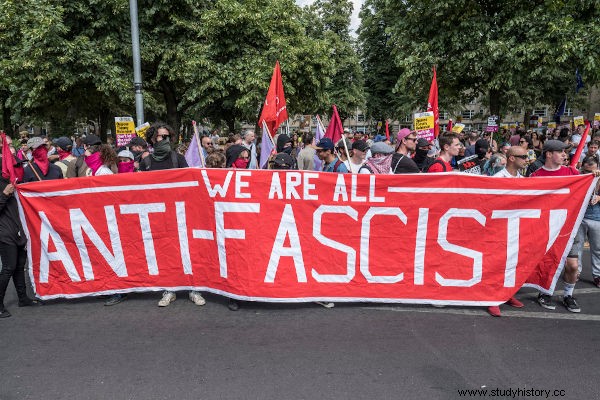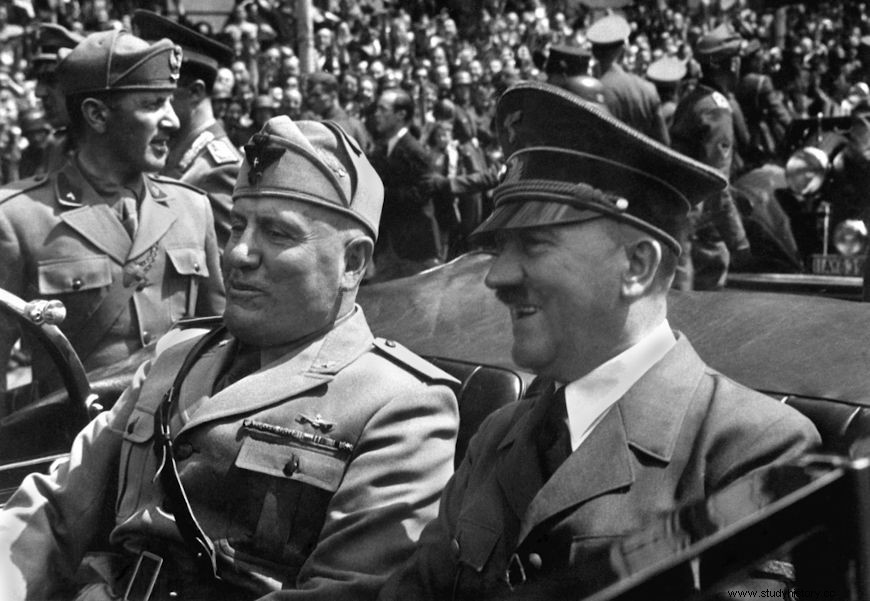The anti-fascism it is a form of action that certain groups adopt to combat the growth of fascism and far-right movements. They act, above all, for the open confrontation against the fascists and have their origin in the 1920s, specifically in the fight against fascism, in Italy, and Nazism, in Germany.
Login also :Nuremberg Laws — Laws that Defined Citizenship in Nazi Germany
How can we understand anti-fascism?
Anti-fascism is not necessarily considered a political movement, but rather a form of action that certain social movements adopt. The basic idea behind the action of anti-fascism is to promote combat to fascism and any far-right political experience. Currently, adherents of this way of acting are also known as "antifa".

Antifa takes direct action to fight fascism and the extreme right, which means that they usually get together and all the members propose measures aimed at improving society. These meetings also discuss the best strategies to combat fascism, and this mobilization of anti-fascists usually takes place without the involvement of major parties.
Anti-fascism has its origins in leftist movements — socialism, communism and anarchism — and brought together individuals with progressive views, who joined forces to stop the advance of fascism and Nazism in Europe during the 1920s and 1930s. This ideological inspiration remains in modern anti-fascism.
The struggle of anti-fascism today aims to fight neo-fascism, the extreme right and the action of groups of supremacists - characteristics that are interconnected. The immigrant defense , the anti-racist struggle , the combat to homophobia and to machismo and the critique of capitalism are other common features of modern anti-fascism.
Emergence
The rise of anti-fascism took place in the 1920s and 1930s , when fascism and Nazism advanced through Italy and Germany, respectively, and motivated the appearance of other movements of the type in other places in Europe. This first anti-fascist action was actually a movement of self-defense against Nazi-fascist violence.

These two decades were marked by the emergence of far-right movements , with fascism and Nazism being the main ones. They were movements with a strong militarist character and used violence to fight their opponents, especially socialists, communists and anarchists.
The emergence of these groups took place after the First World War. The result of this conflict generated resentment and sowed economic crisis, political crisis and a lot of uncertainty in Europe. This strengthened movements that defended ultranationalist, militarist, conservative and anti-Semitic ideals.
Benito Mussolini and Adolf Hitler knew how to surf this wave and gained a lot of popularity. The first was the founder of the political movement known as the Fascio di Combattimento , in 1919, transforming it into a political party in 1921. The second was one of the first members of the National Socialist German Workers' Party in 1919, becoming leader of that party in the 1920s.
In Italy, fascists organized paramilitary groups known as squadristi or camicie nere , black shirts in Portuguese. They were men who attacked striking workers, socialists and communists and were directly responsible for the weakening of socialism in Italy. They had the support of the economic elites to use violence against the Socialists, the group that most frightened Italian elites.
In Germany, the storm troopers played this role , known in German as Sturmabteilung or SA In the German context, this violence was still carried out against Jews, one of the groups most persecuted by the Nazis. Fascist violence generated the anti-fascist reaction, but a precedent for anti-fascism had already taken place in Europe.
This precedent took place in France, during the trial of the Jewish captain Alfred Dreyfus . He was wrongly accused of divulging French military secrets to Germany. His case unleashed strong anti-Semitism in France and groups of progressives rallied to combat the action of French anti-Semitic groups. This action in France is understood as a proto-anti-fascist experience.
Login also :Integralism, Brazilian fascism
Antifascism in Europe
During the 1920s and 1930s, expressive anti-fascist reactions took place, of course, in Italy and Germany, but places like England and Spain also had expressive reactions of the type. As we have seen, they were, in general, self-defense reactions, because fascist violence was channeled against certain groups.
In the case of Italy, the response to fascism took place through the Arditi del Popolo , movement led by Argo Secondari , an anarchist. Also known as arditismo , this Italian anti-fascist group did not link up with the country's major leftist parties and managed to organize forces of thousands of volunteers ready to fight the squadristi .
Arditismo was short-lived because fascism grew rapidly in Italy, even gaining political strength. Furthermore, an organized reaction by Italian anti-fascists took too long to happen and only came at a time when Italian socialism was greatly weakened. When Mussolini came to power in 1922, arditismo lost strength.
In the case of Germany, the anti-fascist reaction was directly linked with the country's major parties:the communist and the social democratic. In Germany, the problem was the storm troopers, which, as they gained strength, began to act more boldly, invading even strongholds of communists and socialists.
From 1929 onwards, the German lefts mobilized and several anti-fascist groups, such as the Alliance of Red Front Combatants and the Steel Front, emerged. The most famous, however, was the Anti-Fascist Action , created directly by the German Communist Party. This group wanted to form a front that could rally the left to fight Nazism. This group's symbol served as an inspiration for modern anti-fascism.
German anti-fascist resistance weakened after the Nazis came to power in 1933. Adolf Hitler used all the power of the Gestapo to fight the anti-fascists, who, by the end of that decade, had already were greatly weakened. In any case, anti-fascist resistance in Germany was significant, as street fighting against storm troopers left hundreds dead on the fascist side.
Login also :Spanish Civil War — war that put anti-fascists in the fight against the advance of fascists in Spain
Modern Anti-Fascism

Anti-fascism didn't die after the fascists and Nazis were defeated in the Second World War, for although fascism weakened, it survived in some extremist groups. Thus, the existence of fascist groups mobilized anti-fascists in different parts of Europe and beyond.
First, anti-fascism extended its fight against every far-right group , not necessarily summing up to fascism. As we have seen, new guidelines were introduced to anti-fascism, which became a political action that advocates:
-
anti-racism;
-
anti-capitalism;
-
fights machismo and homophobia.
Anti-fascists continue to be groups motivated by left-wing ideologies and strongly defend self-management social as a form of political and social organization. They emerged in different places on the planet, making open confrontation and occupying spaces as the main way of fighting fascism.
The open confrontation has lost strength as a strategy of action , as many far-right groups have adopted a more lenient public stance that well masks their extremist and authoritarian tendencies. Still, anti-fascists remain one of the main forces in the fight against the advance of neo-fascism.
Image credits
[1] Edward Crawford and Shutterstock
[2] Everett Historical and Shutterstock
